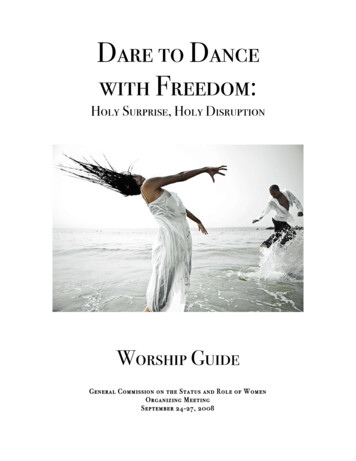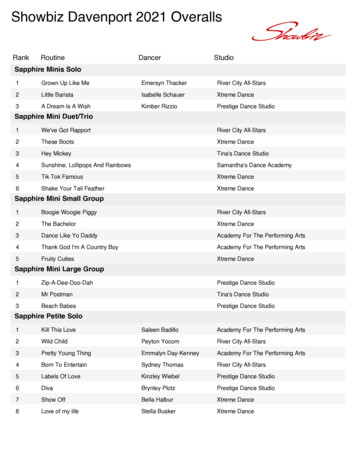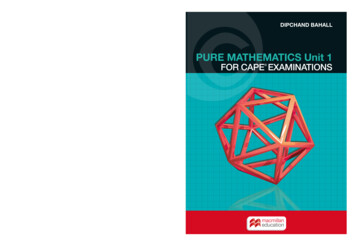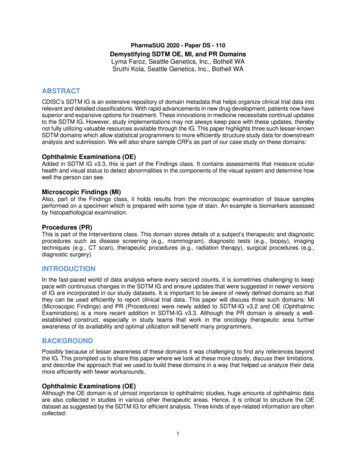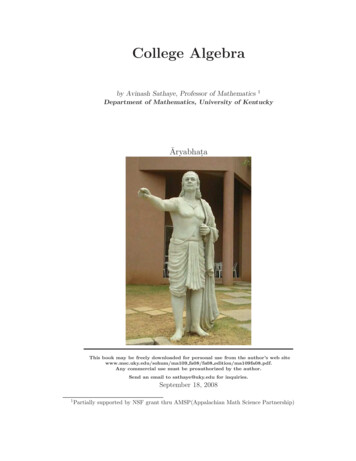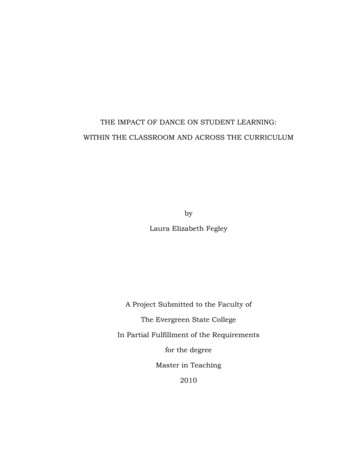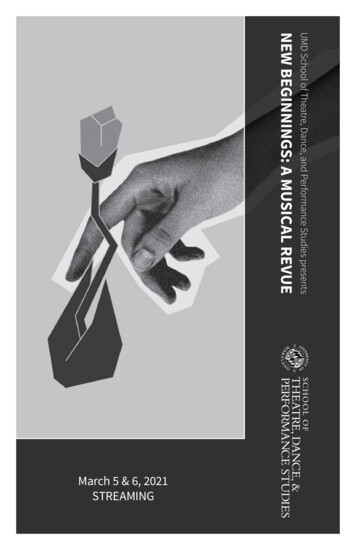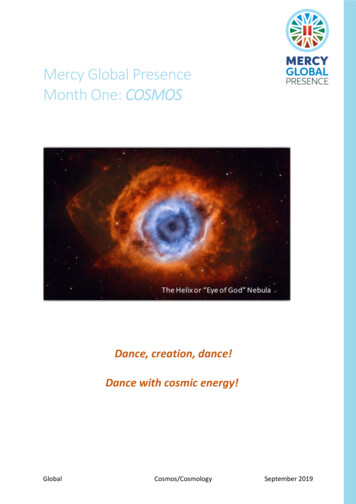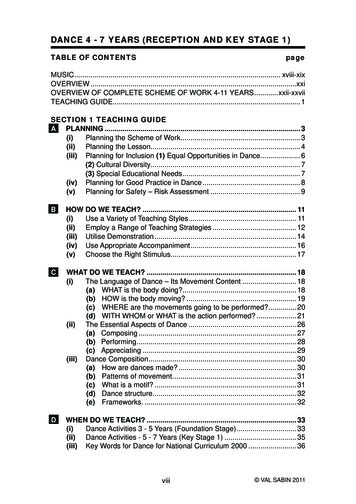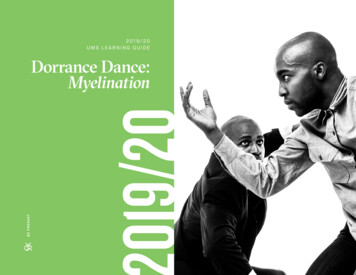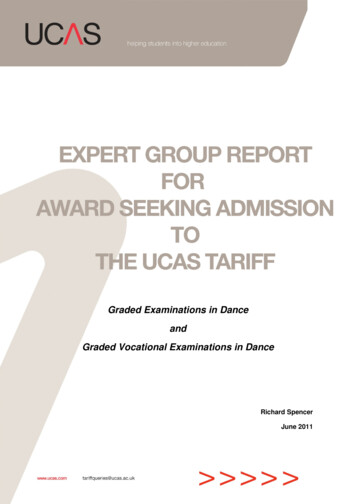
Transcription
Graded Examinations in DanceandGraded Vocational Examinations in DanceRichard SpencerJune 2011
CONTENTSPAGETHE CONDUCT OF THE COMPARABILITY STUDYSECTION 1: SUMMARY AND RECOMMENDATIONS45SECTION 2: CONTEXT FOR THE WORK72.17Background2.1 Qualification and Credit FrameworkSECTION 3: OVERVIEW OF ROYAL ACADEMY OF DANCE QUALIFICATIONS793A: GRADED DANCE EXAMINATIONS (GRADES 6, 7 AND 8)93A.1 Aims and purpose of the qualifications3A.2 History of the qualifications993A.3 Entry requirements for the qualifications3A.4 Age of candidates10103A.5 Size3A.6 Content and structure of the qualification10103A.7 Assessment – procedures, methods and levels113A.8 Grading3A.9 Quality assurance processes3B: VOCATIONAL GRADED EXAMINATIONS IN DANCE: LEVEL 3 CERTIFICATES121314INTERMEDIATE AND ADVANCED FOUNDATION143B.1 Aims and purpose of the qualification3B.2 History of the qualification14143B.3 Entry requirements for the qualification143B.4 Age of candidates3B.5 Size15153B.6 Content and structure of the qualification3B.7 Assessment – procedures, methods and levels15183B.8 Grading3B.9 Quality assurance processesSECTION 4: OVERVIEW OF AQA GCE A LEVEL IN DANCE1919204.14.2Aims and purpose of the qualificationHistory of the qualification20204.34.4Entry requirements for the qualificationAge of candidates21214.54.6Guided Learning Hours (GLH)Content and structure of the qualification21214.7Assessment – procedures, methods and levels224.8 Grading4.9 Quality assurance and code of practiceSECTION 5: SUMMARY OF COMPARISONS AND CONSIDERATIONS2525265.1Overview of processes undertaken265.25.3Comparison of aimsComparison of size27285.4Comparison of content and coverage285.55.6Comparison of assessment models and arrangementsAligning grades30335.7Comparison of Tariff domains34DanceTariffreportQCF2
5.8Strengths and weaknesses345.9 Recommendations for awarding UCAS Tariff points5.10 UCAS Tariff Advisory Group decision makingAPPENDIX 1: BIOGRAPHIES OF THE EXPERT GROUP MEMBERSAPPENDIX 2: THE EVIDENCE CONSIDERED35373842APPENDIX 3: TARIFF DOMAINSAPPENDIX 4: DANCE DESIGN PRINCIPLES (QCF)4347LIST OF TABLES50LIST OF FIGURES50DanceTariffreportQCF3
THE CONDUCT OF THE COMPARABILITY STUDYGiven the demands of conducting comparability studies, and the differences in the types of awardlikely to seek entrance to the UCAS Tariff, the set of procedures and processes to which we adhereare based on the premise that comparisons require collaborative input and judgement from membersof an Expert Panel.Upon receipt of a proposal for Tariff consideration, UCAS staff undertake an initial review of thequalification to ascertain the level and complexity of work involved and a timed and costed work planproposed to the awarding body or sponsor. An appropriate benchmark qualification is selected at thisstage which attracts UCAS Tariff points and is in a related subject, or has a related skills base, toenable comparability.UCAS staff assemble all appropriate paperwork for the qualification seeking entry to the Tariff andtheir chosen benchmark. This documentation (see Appendix 2) is sent to Expert Panel task workersalong with detailed descriptions of the benchmark and qualification applying for Tariff entry, which arereplicated in Section 2.Task workers for this qualification are: Cathy Childs, University of Chichester Jacky Ferguson, Royal Academy of Dance Tracey Tickle, AQA Rachael Meech representing the Council for Dance Education and Training.Brief biographies can be found at Appendix 1.The Expert Panel members undertake a series of comparisons, based upon a detailed set ofquestions used to guide, rather than constrain, their comparability studies. In all the above instancesthose responsible for making these judgements provide cross references to presence of evidence inthe materials considered, or provide a justification for any judgements made. The outcomes aresummarised at section 5.All evidence and considerations are considered by the Tariff Advisory Group (TAG) which iscomprised of admissions practitioners from higher education institutions. TAG makes judgementspresented as suggested allocations of UCAS Tariff points that first and foremost take account of theamount of ‘utility’ or ‘relevance’ of an award for use in progression to UK HE. A secondaryconsideration in determining an appropriate Tariff value will be the size of the award involved. Thevalidity of the judgements to be undertaken is achieved through: detailed scrutiny of a range of evidence about the utility of a qualification seeking entry to theUCAS Tariff, and the actual use made of that qualification for entry to UK higher educationinstitutions careful documentation and detailed reporting of the decision pathways taken in allocating pointsto a qualification.DanceTariffreportQCF4
SECTION 1: SUMMARY AND RECOMMENDATIONSThis report provides an overview of the considerations made in allocating UCAS Tariff points forgraded examinations in dance and vocational graded examinations in dance. Rather than undertakein-depth analyses of all dance qualifications individually, it was agreed that the Royal Academy ofDance qualifications be considered as representative of all graded and vocational graded dancequalifications.Following an in depth analysis of the similarities and differences between the RAD qualifications andthe AQA GCE A level in Dance, the following issues were taken into account in recommending UCASTariff points: The content and skills in the graded and vocational graded qualifications are at a comparablelevel to the practical units of the GCE A level The practical units of the GCE A level constitute 55 per cent of the total qualification In terms of comparative size the graded qualifications are between 25 and 36 per cent of theGCE A level, whilst the vocational graded qualifications are between 63 and 78 per cent of thesize Assessment methods and outcomes for the performance elements of all qualifications arecomparable, but the GCE A level also includes written examinations which are not required forthe graded and vocational graded qualifications Tariff domain scores for the graded and vocational graded qualifications are lower than those forthe GCE A level across the board – mainly due to the lack of critical thinking and writtenassessments The graded and vocational graded qualifications could arguably be considered to be related toother similar qualifications which are already in the Tariff eg music, speech and dramaexaminations. The graded and vocational graded qualifications adopt a mastery model of assessment wherebya minimum of 40 per cent is required in all elements in order to pass, whereas the GCE A level isassessed through a compensatory model which allows for candidates to pass the qualificationwithout having to pass every unit. Whilst the GCE A level adopts a formative assessment approach, whereby candidates canrepeat a performance to improve, the graded and graded vocational qualifications rely upon aonce only demonstration. This issue of criticality has previously been taken into account in theTariff considerations for graded music, speech and drama qualificationsThe Expert Panel proposed ignoring the written element of the GCE A level in aligning the graded andvocational graded qualifications, instead focusing solely on alignment with the practical elements ofthe GCE A level. This was considered to constitute 55 per cent of the total Tariff points.In aligning grades, the Panel suggested that a pass in the graded and vocational graded qualificationswould nominally equate to a GCE A level C grade. Given differences in content and learningoutcomes between grades 6, 7 and 8 there was a need to differentiate between these three grades.The approach taken in developing the graded dance qualifications was identical to that taken forgraded speech and drama qualifications.DanceTariffreportQCF5
In reviewing Tables 15 and 16 in this report, there is noticeable consistency between the proposedTariff points for grade 8 pass and distinction using both methodologies. However, it was noted that thegraded dance qualifications are developed with an even mark allocation for the level of demandbetween pass and distinction. The Panel agreed that distinction at grade 6 graded dance qualificationequated to 40 Tariff points – partly based on equivalence to the graded speech and drama Tariffpoints, and partly to the assertion that the graded qualifications require roughly 30 per cent of thestudy time of the GCE A level.Further analysis of the differences between grades 6, 7 and 8 implied that they should be equallyincremental in terms of their demand and ability to prepare students for HE. It was also recognisedthat some weight should be given to the potentially greater assessment demand of the gradedexaminations than the GCE A level performance units.As a result of these considerations, the following Tariff points were agreed by the Tariff AdvisoryGroup.Grade 8Grade 7Grade 6Tariff ssDistinction40MeritPass3530The Panel agreed that the vocational graded qualifications concentrate on developing the same skillsand are assessed in the same way as the graded qualifications. However, the vocational gradedqualifications are larger, contain more content and have greater focus and depth have higherexpected standards than the graded qualifications. Distinction in the Advanced Foundationqualification was equated to a GCE A level grade A in terms of assessment demand.Recognising all these factors, the following Tariff points were agreed by the Tariff Advisory Group.Advanced 5040DanceTariffreportQCF6
SECTION 2: CONTEXT FOR THE WORK2.1BackgroundUCAS was approached in 2009 by The British Ballet Organisation (BBO), British Theatre DanceAssociation (BTDA), Imperial Society of Teachers and Dancing (ISTD) and Royal Academy of Dance(RAD) to consider allocating Tariff points to their graded and vocational graded examinations indance, which at the time were accredited on the National Qualifications Framework (NQF). Thisfollowed a series of comparability and standardisation exercises undertaken by the four awardingorganisations covering: syllabus/specification examination timings mark schemes and quality criteria-descriptions of level-learning outcomes-assessment criteria grading candidate evidence.The purpose of these exercises was to compare documentation and candidate performance fromeach awarding body to ensure that each awarding body is offering comparable levels of demandwithin their syllabuses. The conclusion was as follows:‘In summary, all the documentation provided by the four awarding bodies can be said tobe broadly comparable and the differences within the syllabuses can be explainedthrough the different approaches employed by the individual awarding bodies to thedevelopment of the syllabus, marking and grading procedures. In terms of comparability,the written documentation can be said to be comparable in terms of level of demandexpected from candidates.’This collective approach is similar to the process undertaken for graded examinations in speech anddrama and music and, as such, UCAS is willing to accept this joint submission for consideration ofUCAS Tariff points.2.1Qualification and Credit FrameworkDuring 2010, the graded examinations offered by each awarding body were transferred from theNational Qualifications Framework (NQF) to the new Qualifications and Credit Framework (QCF).The QCF sets out how regulated vocational qualifications are structured, titled and quality assured. Itwas originally designed to replace the National Qualifications Framework across England, Wales andNorthern Ireland.In the QCF every unit and qualification has a credit value and a level. One credit represents ten'notional' hours of learning, which includes both Guided Learning Hours (GLH) and independentlearning hours, and shows how much time the qualification takes to complete. Levels vary from entrylevel to level 8. There are three sizes of qualifications in the QCF: Awards (1 to 12 credits)DanceTariffreportQCF7
Certificates (13 to 36 credits) Diplomas (37 credits or more)All units in the QCF use a standard unit template, consisting of learning outcomes (what a learnerneeds to know, understand or do) and assessment criteria (which specify if the learner has met theoutcomes to a defined level). Some units will appear in more than one qualification and the credit canbe transferred between qualifications, as long as it forms part of the ‘rules of combination’ of thequalification to which credit is being transferred. Units can be shared across awarding organisationsand developed in collaboration.A summary of the agreed design and operating rules for a common approach by BBO, BTDA, ISTDand RAD to graded and vocational graded examinations in dance within the Qualifications and CreditFramework can be found at Appendix 4.Following analysis of the NQF graded dance examinations and their QCF successors, this report setsout the recommendations for the allocation of Tariff points to the QCF versions of the graded danceexaminations. Due to the agreement amongst the awarding organisations that their qualifications arecomparable in terms of level of demand expected from candidates, in-depth consideration will begiven to a representative example of the graded and vocational graded examinations.The specifications to be considered in detail are: RAD graded examinations in dance: Classical Ballet (Grades 6, 7 and 8) RAD vocational graded examinations (Intermediate and Advanced Foundation).DanceTariffreportQCF8
SECTION 3: OVERVIEW OF ROYAL ACADEMY OF DANCE QUALIFICATIONS3A: GRADED DANCE EXAMINATIONS (GRADES 6, 7 AND 8)3A.1Aims and purpose of the qualificationsThe aims of the graded qualifications are to: promote the study of ballet and related dance disciplines as a leisure and/or vocational activity provide a means of measuring the acquisition of technical, musical and performance skills inballet and related dance disciplines promote and encourage enjoyment of movement as a form of physical exercise provide all candidates, particularly children and young people, with an opportunity ofexperiencing various dance disciplines accompanied by live music encourage personal self-confidence and group awareness through the experience of dancingsolo, in partners and in small groups develop a general appreciation of music through dancing to various musical styles and rhythmicpatterns motivate students by providing a series of clearly defined goals which have been structured toreflect the principles of safe dance practice provide teachers with a vehicle to measure the individual progress of their students.A course of study based on these qualifications is intended to provide students with: an increasing ability to demonstrate practical knowledge of the dance disciplines of ballet, freemovement and character a graduated measure of attainment against specific criteria increasing self-confidence through the learning, memorising and performing of prescribedsequences of movement, studies and dances an awareness and understanding of working with others an appreciation, through practical experience, of three contrasting dance disciplines with theiraccompanying music.3A.2History of the qualificationsThe RAD launched ‘a series of examinations in dancing for children’ in 1930. Since that time theexaminations have undergone a number of revisions and associated changes of name, includinggrade examinations and ballet in education examinations.Until the early 1990s the highest level was Grade 5. At this time, Grades 6, 7 and 8 were introducedas an alternative for those who, for a variety of reasons, wished to continue their study of dancebeyond Grade 5 but did not wish to pursue the vocational graded route more geared towards theaspiring professional dancer. Initially Grades 6, 7 and 8 were available for female candidates only;male syllabuses were introduced from 2005.Grades 1 to 8 were placed on the National Qualifications Framework in 2001, at which point theywere retitled graded examinations in dance in order to conform to QCA requirements. In 2010 theywere transferred to the Qualifications and Credit Framework.DanceTariffreportQCF9
3A.3Entry requirements for the qualificationsIt is recognised that many candidates will have passed previous graded examinations, but this is notessential provided they satisfy the minimum age requirements.3A.4Age of candidatesFor reasons of safe dance practice, candidates for Grades 6, 7 and 8 must have reached the age of11 years by 31 December in the year of the examination. There are no maximum age limits for any ofthe graded examinations.3A.5SizeLearners undertaking a course of study leading to Grades 6, 7 or 8 are recommended to complete 90guided learning hours with an additional 40 hours dedicated to practice. These guidelines areconsistent with the rationale developed by the UK dance awarding organisations in 2009 for thedetermination of credit values on the QCF. The rate of learning of individual students may vary, andthe length of training for each student before entering for examination is at the discretion of theteacher.Overall it is recommended that 130 notional learning hours (NLH) are dedicated to each grade.3A.6Content and structure of the qualificationThe content and structure of graded dance qualifications is summarised in Table 1:Table 1: Content and structure of graded dance qualificationsGrade 6Grade 7Grade 8 AwardFor the examination, all exercisesshould be prepared, except thatthere is a choice of classical, freemovement or character dance.For the examination, all exercisesshould be prepared, except thatthere is a choice of classical, freemovement or character dance.The Grade 8 award develops soloperformance as a culmination of thegraded examination syllabus.Candidates are required to performsolos in the three styles of dancepreviously studied - classical, freemovement and character preceded by a short warm up barre.The first dance (Etude Lyrique) iscompulsory, but in all other sectionsthere is a choice of dance.Classical exercisesClassical exercisesClassical exercisesBarreBarreBarre Pliés Battements tendus andbattements glissés Ronds de jambe à terre andbattements fondus Battements frappés Exercise for ronds de jambe enl'air with port de bras Adage Grands battements andbattements en cloche Demi-pointe enchaînement Pliés Battements tendus andbattements glissés Ronds de jambe à terre andbattements fondus Battements frappés Ronds de jambe en l'air Adage study Grands battements andbattements en cloche Coupé fouetté raccourci Pliés Battements tendus andbattements glissés Ronds de jambe à terre andbattements fondus Battements frappés Adage Grands battementsCentreCentrestnd 1 Port de bras or 2 Port debras Port de brasDanceTariffreportQCF10
Pirouette enchaînementAdagePetit allegroAllegro Exercise for temps liésPirouette en dehorsPirouette en dedansAdage studySoubresauts and echappésthsautés to 4 position Pas de bourrées Petit allegro Waltz enchaînementGrand allegro To be performed as a solo –candidate’s choice of sides To be performed as a solo –candidate’s choice of sidesClassical dance (if chosen)Classical dance (if chosen )Classical solos To be performed as a solo To be performed as a solo Etude lyrique Valse printemps or demicaractèreFree movement sequencesFree movement sequencesFree movement solos Exercise for upper back Exercise for elevation and use ofspace Free movement dance (ifchosen) To be performed as a solo Character enchaînements(Polish) Polonaise Polish mazurka and pas marché Krakoviak Study in stillness and gravity Study for upper back Free movement dance (ifchosen) To be performed as a solo Character enchaînements(Hungarian court) Letjö and promenades Cabrioles and quick letjö Retirés and pas de bourrées Mouvement libre poétique orMouvement libre dramatique Character solos Mazurka desalon or danseRusse Finale polonaise and révérence Character dance – Polishmazurka (if chosen) To be performed as a duet onopposite sides or as a solo Character dance - czardas (ifchosen) To be performed as a duet onopposite sides or as a soloEntrée polonaiseCharacter révérenceCharacter révérenceProps required: long silk scarf forfree movementProps required: long silk scarf forfree movementProps required: long silk scarf(female) or cloak (male) for freemovement; smallhandkerchief for danse Russe3A.7Assessment – procedures, methods and levelsExaminations are held in a variety of approved locations worldwide, overseen by more than 200examiners. Candidates may re-take an examination as many times as they wish, regardless of theresult. Assessment time depends upon the number of candidates in the set, as portrayed in Table 2.Table 2: Graded dance examinations assessment timeNumber in setGradeGrade 8Grade 7Grade 61234353535404040505050605555Learning objectives/ outcomesBy the end of Grades 6, 7 and 8, students will have achieved the learning outcomes summarised inTable 3.Table 3: Learning outcomes for graded dance qualificationsDanceTariffreportQCF11
TechniqueMusicPerformanceBalletFree movementCharacter Demonstrate secureposture and correct weightplacement in theperformance Of a wide range of morecomplex movements Demonstrate an ability toperform a wide range ofcomplex movements withcoordination of the wholebody, well stretched legsand articulated footwork Demonstrate line throughthe body and use ofépaulement Demonstrate an ability toperform more complexmovements with accuratealignment and use of space Demonstrate well coordinated turning actionswith correct use ofsupporting leg andplacement of working leg Demonstrate elevation withcontrolled landings in awide range of morecomplex steps. Perform with correct andaccurate timing andappropriate response to themusic. Perform a wide variety ofsimple and complex stepswith free flowing movement Use of space and coordination of the wholebody, showing a secureUnderstanding of weighttransference, use ofgravity, suspension at theclimax of a movement andcontrolled endings Demonstrate use of gravityand relaxation of upperback to project morecomplex movements intoand through space Demonstrate an ability toshow a variety of linesthrough the whole bodyusing a wide range ofcomplex movements Demonstrate varyingheights of elevation withspring off one leg in morecomplex movements Demonstrate proficient useof long scarf Perform a wide range ofcomplex steps with firmhold of the body, upperback and head, accurateplacement of the arms andhands, use of deep fondu,use of space andarticulated footworkrelevant to the style, use ofépaulement Demonstrate an ability tocontrast differing qualitiesof movements and steps Demonstrate a morecomplex co-ordinatedturning action Perform with correct andaccurate timing andappropriate response to themusic. Perform with expressionand communication Perform with expressionand communication Perform with correct andaccurate timing andappropriate response to themusic; Perform exercises to musicwith varied rhythmicstructures. Perform with expressionand communicationPerformance descriptions (Grades 6, 7 and 8)In progressing through these level 3 qualifications, candidates are expected to demonstrate acomprehensive knowledge and understanding of the vocabulary of a particular style through the widerange of movements performed with technical strength. Along with confidence, candidates will conveyself-awareness, resulting in a sensitive personal responsiveness to the musical mood.Candidates will demonstrate a mature awareness of audience as well as subtleties of performancecombined with expression and fluidity of movement involving dynamics and use of space.3A.8GradingThe graded dance qualifications are graded on a pass, merit and distinction basis as outlined in Table4.Table 4: RAD graded dance qualifications gradingPassMeritDistinction40 – 54 marks55 – 74 marks75 – 100 marksDanceTariffreportQCF12
The assessment of the candidate’s performance in each section of the examination is delivered usingthree interrelated domains of assessment - technique, music and performance.These domains of assessment are broken down into assessment criteria which are applied asappropriate to the various requirements of the examination. These criteria are normally applied to thefull range of examination content for each section of the examination and relate to specified learningobjectives and outcomes.Each assessment criterion comprises a number of interrelated elements, which increase in number asthe examinations increase in level, thus increasing the demands placed on the candidate.In the examination, the examiner awards a mark of between 0 and 10 for each assessment criterion.A mark of 1 or higher signifies the standard attained by the candidate with respect to that criterion. Amark of 0 signifies that no work was shown for all or part of the section of the exam relating to thatcriterion. Attainment descriptors explain the level of mastery which the candidate needs todemonstrate in order to achieve these marks.For examinations at Grade 6 and Grade 7, there is no requirement to pass any specific section of theexamination; the 40% marks required to pass may come from any section.For Grade 8, candidates are required to achieve a minimum of 40% (ie 8 marks out of 20) for eachdance in order to pass overall.3A.9Quality assurance processesThe RAD has a number of policies in place to ensure continuous quality improvement. These areformally documented and include examiner recruitment and training, equality and diversity, monitoringthe work of examiners, recognition of prior learning, complaints and appeals.The task of ensuring ongoing quality assurance, including compliance with regulatory criteria, ismanaged by the examinations quality assurance committee. This committee is chaired by the directorof examinations, reports to the artistic and examinations sub-committee of the board of trustees andmeets every six to eight weeks.The examinations quality assurance committee carries out an annual internal audit of theexaminations board’s activities, against regulatory criteria. Each member of the committee isresponsible for auditing a different area(s) and reporting on their findings, as delegated by the directorof examinations who, as chairman of the committee, oversees the process. The reports arecompleted with reference to the current regulatory criteria and with reference to the action plan arisingfrom the previous annual audit. The information provided in these reports is collated into a singlereport.DanceTariffreportQCF13
3B: VOCATIONAL GRADED EXAMINATIONS IN DANCE: LEVEL 3 CERTIFICATESINTERMEDIATE AND ADVANCED FOUNDATION3B.1Aims and purpose of the qualificationThe aims of the vocational graded qualifications are to: provide a means of measuring the acquisition of technical, musical and performance skills inballet provide candidates with a sound ballet base in preparation for further training and a career indance or dance related subjects provide a progressive measure of attainment in ballet against specific criteria provide candidates with a series of clearly defined goals, which reflect the principles of safedance practice provide candidates with an opportunity to gain internationally recognised qualifications in ballet toan advanced level.A course of study based on these qualifications aims to provide students with an increasing ability todemonstrate in-depth knowledge and practical skills in ballet.3B.2History of the qualificationThe RAD’s vocational graded examinations can be traced back to the organisation’s founding in1920, when entrance to membership of the organisation was by examination. Over time, with theadvent of the children’s syllabus in 1930, membership examinations became known as majorexaminations and more recently (2001), vocational graded examinations.Formerly known as elementary, intermediate and advanced, a pre-elementary level was introduced inthe 1970s, and at a later stage Intermediate was divided into two parts. In 2001 the five levels wereretitled Intermediate Foundation, Intermediate, Advanced Foundation, Advanced 1 and Advanced 2.Vocational graded examinations have for some years been positioned as the ‘professional’ route: theircontent promotes a depth and focus of study which is geared towards the aspiring professionaldancer rather than the individual who wishes to explore dance as a hobby and a means of personaldevelopment. Historically, achievement at Intermediate level (formerly elementary) has been seen asan appropriate entry route to further study at vocational schools and similar institutions.The RAD’s vocational graded examinations were placed on the NQF in 2001 at levels 2 and 3. Theirtransfer to the Qualifications and Credit Framework (QCF) in 2010 was accompanied by a revision oflevels so that they now spread across levels 2, 3 and 4. Accordingly, Intermediate and AdvancedFoundation now constitute the Academy’s vocational graded provision at level 3.3B.3Entry requirements for the qualificationThere are no entry requirements for Intermediate level. Candidates must have passed Intermediatebefore taking Advanced Foundation.DanceTariffreportQCF14
Candidates may take the Advanced Foundation if they hold the equivalent pre-requisite vocationalgraded qualification in classical ballet from other recognised awarding organisations.3B.4Age of candidatesMinimum age for entry (to be attained by 31 December in the year of the examination) Intermediate: 12 years Advanced Foundation: 13 yearsThere are no maximum age limits for any of the vocational graded examinations.3B.5SizeBoth the Intermediate and Advanced Foundation qualifications have a credit value of 28 credits.Notional learning hours (NLH) are set at 275 of which a minimum of 150 are guided learning hours(GLH).R
SECTION 2: CONTEXT FOR THE WORK 7 2.1 Background 7 2.1 Qualification and Credit Framework 7 SECTION 3: OVERVIEW OF ROYAL ACADEMY OF DANCE QUALIFICATIONS 9 3A: GRADED DANCE EXAMINATIONS (GRADES 6, 7 AND 8) 9 3A.1 Aims and purpose of

